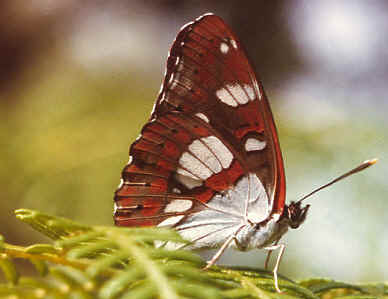|
|

|
|
checklist
|
|

|
|
butterfly gallery
|
|
|
______________________________________________________________________
BUTTERFLIES
The history of butterfly recording on Thásos is not extensive and the first
significant contribution appeared as recently as 1991 (Littler 1991). Five years
later, J.D. Holloway (1996) published a review of the butterfly fauna of Thásos,
listing sixty-eight confirmed species. Possible records of a further six species
are discussed and one of these, Anthocharis gruneri, has since been
confirmed (Abadjiev 2000). Pamperis (1997) maps records for 62 species for
Thásos, including five not mentioned by Holloway. However, Pamperis indicates
that these are unconfirmed and the record of Pyrgus serratulae has since been withdrawn.
Leptidea duponcheli, mapped by Pamperis, has recently been
confirmed by Sylvia van Leeuwen and Bart van Tooren. I have added Pyronia
tithonus, seen in open woodland above Potamia in 2007. Four more potential
additions were included in a list of butterflies recorded from Skala Potamias
(Chilton 1999). In 2011 & 2012 Langourov et al. (2013) discovered Chilades
trochylus breeding on the south coast of the island. This amounts to a total of eighty-five butterfly species which
have been reported from Thásos.
In a comprehensive review of the butterfly fauna of the Aegean islands,
Dennis et al (2001) consider that 69 species have been reliably recorded
from Thásos (more than for any other Aegean island) and predict that a further
five species should be recorded given their distribution in the region. One of
these, Charaxes jasius has already been reported by Chilton (1999) and
hence should be added to the Thásos list. The information presented in Dennis et
al (2001) indicates that seven of the unconfirmed species included in
Holloway (1996), Pamperis (1997) and Chilton (1999) have not been recorded on
any of the Aegean islands and are therefore unlikely to have been correctly
identified. The remaining six species (plus Heodes tityrus reported in
2002) are possibly present on Thásos but
confirmation is desirable. The addition of Leptidea duponcheli (which is
otherwise known in the Aegean only from Samothraki) and Pyronia tithonus was not predicted by Dennis et
al (2001) and, thus, the Thásos checklist consists of seventy-three confirmed species, seven unconfirmed species, and a further four that should be
present but have probably been overlooked. Holloway (1996) attributes this
diversity to the lush wooded habitats of Thásos and its proximity to the Greek
mainland. This is supported by the detailed analysis presented by Dennis et
al (2000, 2001), who conclude that distance from mainland coasts and island area
are the main factors in promoting butterfly diversity on the Aegean islands. The
only other islands with more than sixty recorded species are Lesvos and Samos,
eastern Aegean islands that are very close to the coast of Turkey.
Various browns and blues predominate amongst the Thásos fauna but there is
also the spectacle of the swallowtails and, locally in coastal areas such as
Skala Potamia, the beautiful southern festoon. In the uplands, as on the flanks
of Profitis Ilias, Queen of Spain fritillaries sparkle on montane limestone
grassland amongst the pine forests. Despite this diversity, butterflies are
rarely abundant on Thásos, with most individuals being seen during early summer
in the low-lying olive groves in the cool of late afternoon. Dennis et al (2001)
comment that "a striking feature of the Greek islands is the very low
population density of many species" and speculate that this may be due to
predation by ants.
Whilst many species are easy to identify with standard European field guides,
such as Higgins & Hargreaves (1983), there are difficult groups amongst the
graylings, blues and skippers, for instance, that require careful scrutiny and
occasionally dissection for accurate identification. Pamperis (1997) provides a
lavish and beautifully illustrated account of the Greek fauna with hundreds of
stunning photographs but some of the identification characters employed in this
book for the more difficult species have since been questioned.
REFERENCES
Abadjiev, S. 2000.
Anthocharis gruneri gruneri Herrich-Schaffer, (Lep.: Pieridae) new for
the Greek Islands. Entomologist's Record and Journal of Variation, 112:
131-132.
Chilton, L. 1999. Plant
list for Thasos. Marengo Publications.
Coutsis, J. 1979.
About two recent butterfly records from the island of Thassos, Greece. Entomologist's
Record and Journal of Variation., 91: 57
Dennis, R.L.H.,
Shreeve, T.G., Olivier, A. & Coutsis, J.G. 2000. Contemporary geography
dominates butterfly diversity gradients within the Aegean archipelago
(Lepidoptera: Papilionoidea, Hesperoidea). Journal of Biogeography, 27:
1365-1383.
Dennis, R.L.H.,
Olivier, A., Coutsis, J.G. & Shreeve, T.G. 2001. Butterflies on islands in
the Aegean archipelago: predicting numbers of species and incidence of species
using geographical variables. Entomologist's Gazette, 52: 3-39.
Higgins, L.G.
& Riley, N.D. 1983. Field guide to the butterflies of Britain and Europe.
London, Collins.
Holloway, J.D.
1996. The butterflies (Lepidoptera) of the northern Aegean island of Thásos. Entomologist's
Gazette, 47: 143-149.
Langourov, M.S., Simov, N.P. & Abadjiev, S.P. 2013. Chilades trochylus (Freyer,
[1845]) (Lep.: Lycaenidae), new for the North Aegean Islands. Entomologist's
Record and Journal of Variation, 125: 137-143.
Littler, E. A.
1991. Autumn and spring butterflies of Thassos (Lepidoptera: Hesperioidea &
Papilionoidea). Phegea, 19: 25-28.
Pamperis, L. 1997.
The butterflies of Greece. Bastas-Plessas, Athens.
|



